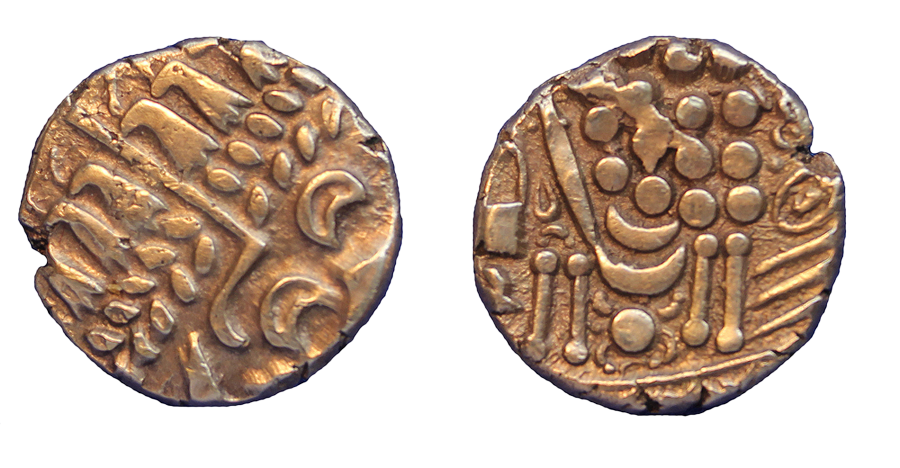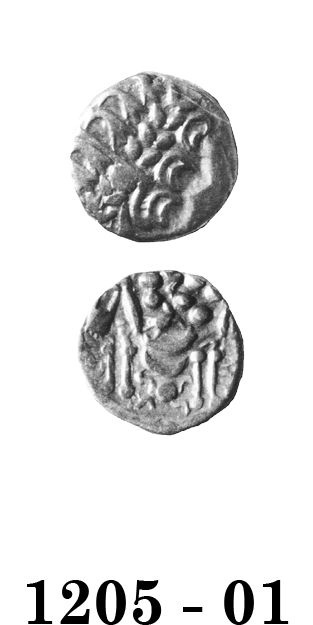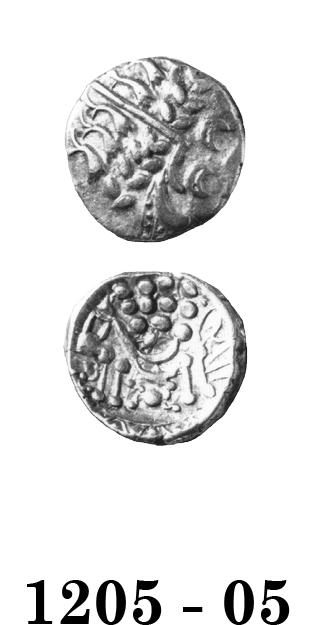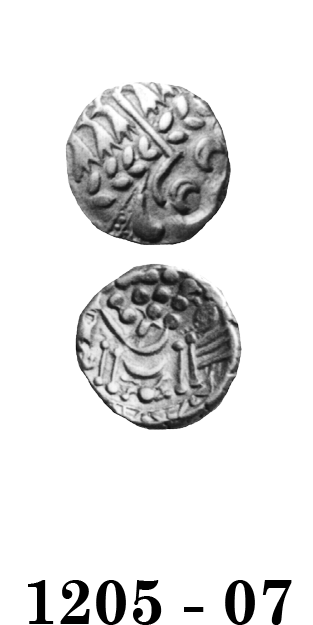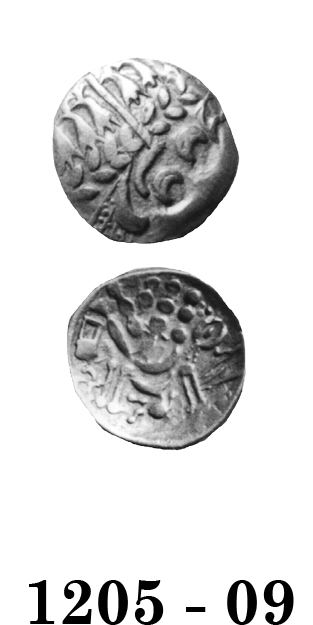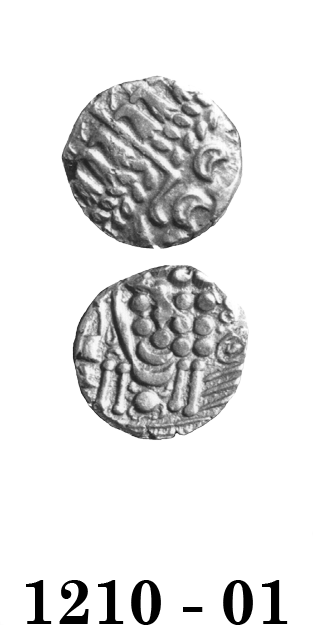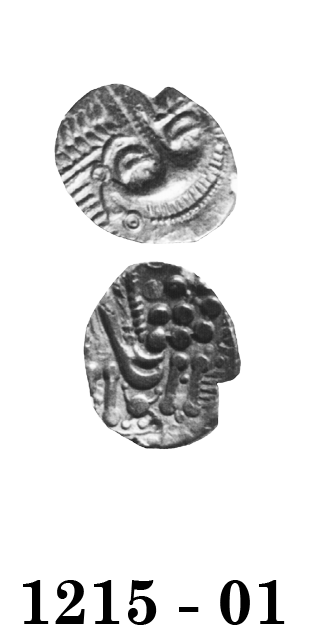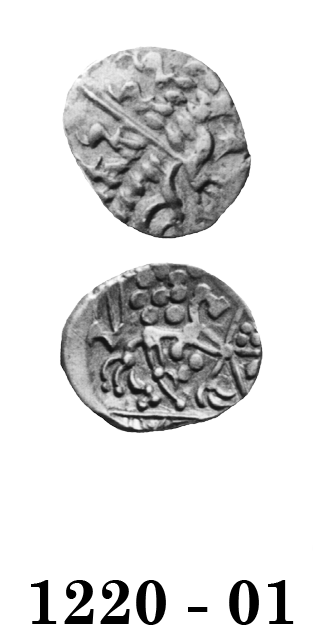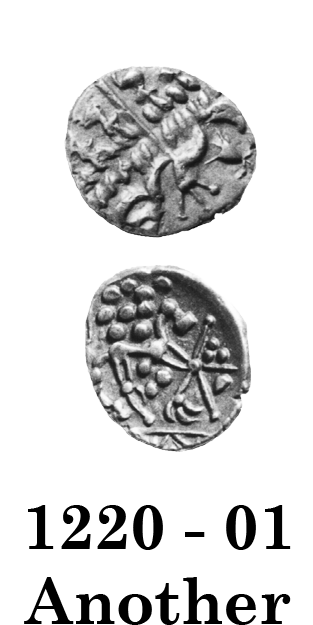
Celtic Coinage of Britain
third edition
Click on coin to see hidden information
Durotrigan Gold Coinage
The first gold coins were struck after the appearance of the Westerham Type of the Atrebates. The Durotrigan adaptation replaced the pellet below the horse with a crab-like object, and placed a "bug" above the animal. These coins were gradually replaced with more debased types, probably intended for external trade in Britain. The tribe's internal coinage became entirely silver around the middle of the Gallic War.
The earliest gold pieces are reasonably common today, not because they were struck in large quantities, but rather because of several hoards found the last century, one near Chute.
There have been recent attempts to reassign these coins to the territory of the Atrebates/Regni/Belgae, but the evidence is increasingly doubtful.
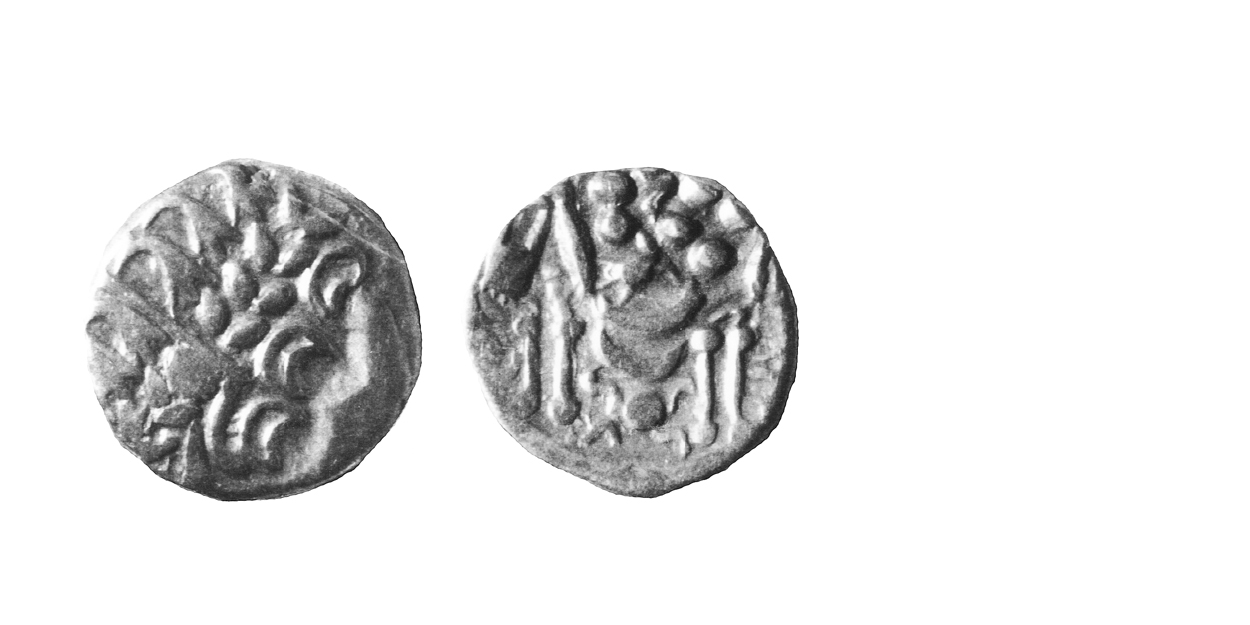
1205 - 01 Chute Type
65-55 B.C. Common
Gold Stater 6.2 gms. 19 mm
Earliest Record: Evans, 1864
OBV: Abstract head of Apollo right
Identifying points:
1) spike with long crescent
2) wreath: leaves downwards
REV: Disjointed horse left
Identifying points:
1) 'crab' comprised of pellet with four wavy arms below horse
2) second 'crab' or 'bug' comprised of oval pellet with five arms above horse
3) 'coffee bean' motif with arms above tail
4) reverse spiral below horse's head
CLASSIFICATION: Durotrigan A
NOTES:
- Some in museums
- Modern forgeries known, not illustrated
- Standard Weight given
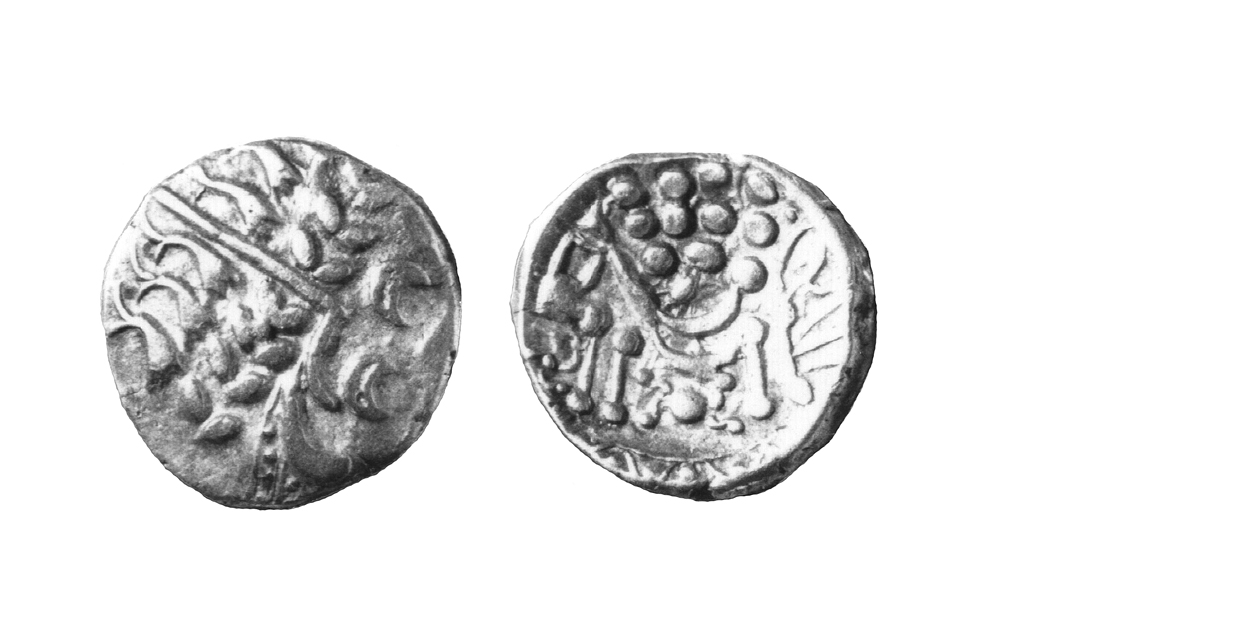
1205 - 05 Chute Type
65-55 B.C. Common
Gold Stater 6.2 gms. 19 mm
Earliest Record: Cunnington, 1928
OBV: Abstract head of Apollo right
Identifying points:
1) as 1205 - 01
REV: Disjointed horse left
Identifying points:
1) as 1205 - 01, but pellets are added to the ends of the crab's arms
CLASSIFICATION: Durotrigan A
NOTES:
- Some in museums
- Standard Weight given
- Addition of the pellets to the arms is believed to be privy mark indicating a reduction in the gold content
- Metallurgical analyses of two coins show a reduction from 35.93 to 30.61 per cent with the change in type.
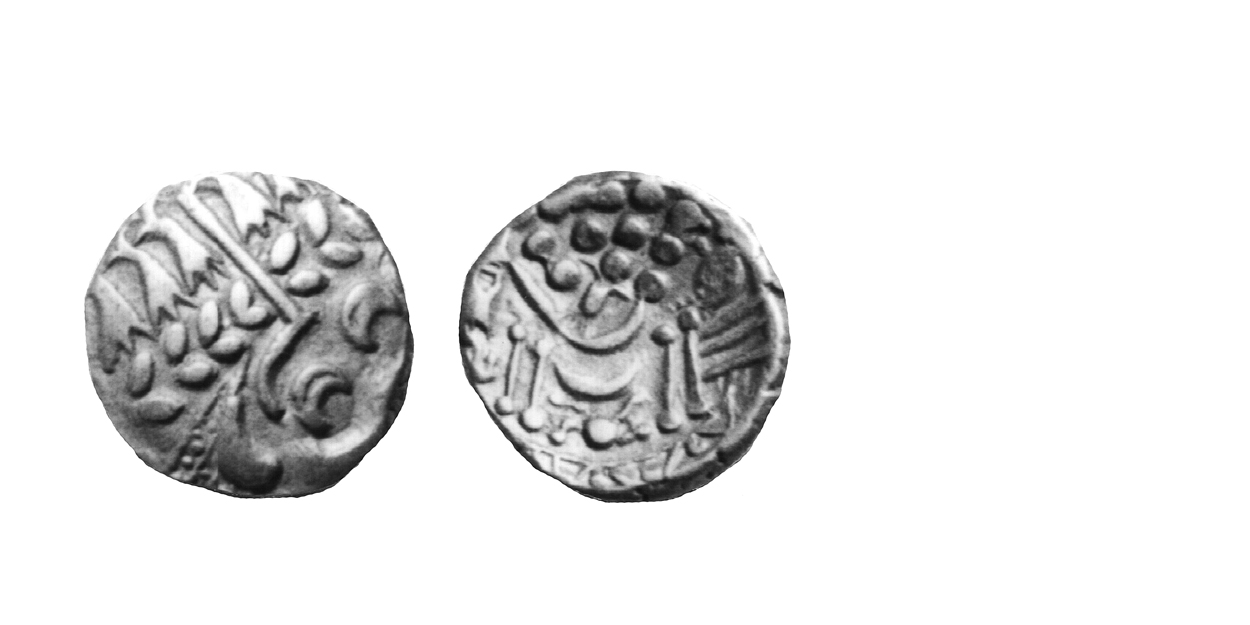
1205 - 07 Chute Type
65-55 B.C. Extremely Rare
Gold Stater 6.2 gms. 17 mm
Earliest Record: Van Arsdell, 1989
OBV: Abstract head of Apollo right
Identifying points:
1) as 1205 - 01
REV: Disjointed horse left
Identifying points:
1) as 1205 - 01, but row of small pellets near 'coffee bean'
CLASSIFICATION: Durotrigan A
NOTES:
- Some in museums
- Probable Standard Weight given
- Addition of row of small pellets to reverse may indicate a change in metal-content, but metallurgical analyses have not been conducted to verify this
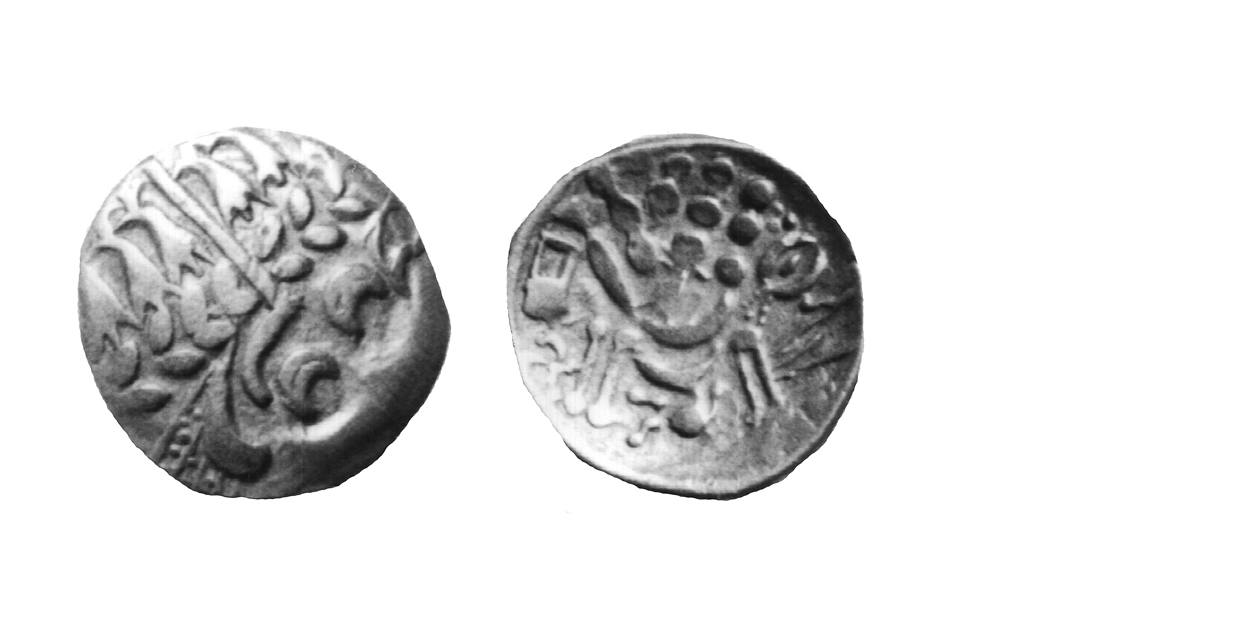
1205 - 09 Chute Type
65-55 B.C. Extremely Rare
Gold Stater 6.2 gms. 19 mm
Earliest Record: Van Arsdell, 1989
OBV: Abstract head of Apollo right
Identifying points:
1) as 1205-1
REV: Disjointed horse left
Identifying points:
1) as 1205-1, but three rows of small pellets near 'coffee bean'
CLASSIFICATION: Durotrigan A
NOTES:
- Most in museums
- Probable Standard Weight given
- Addition of rows of small pellets may indicate change in metal-content, but metallurgical analyses have not been conducted to verify this
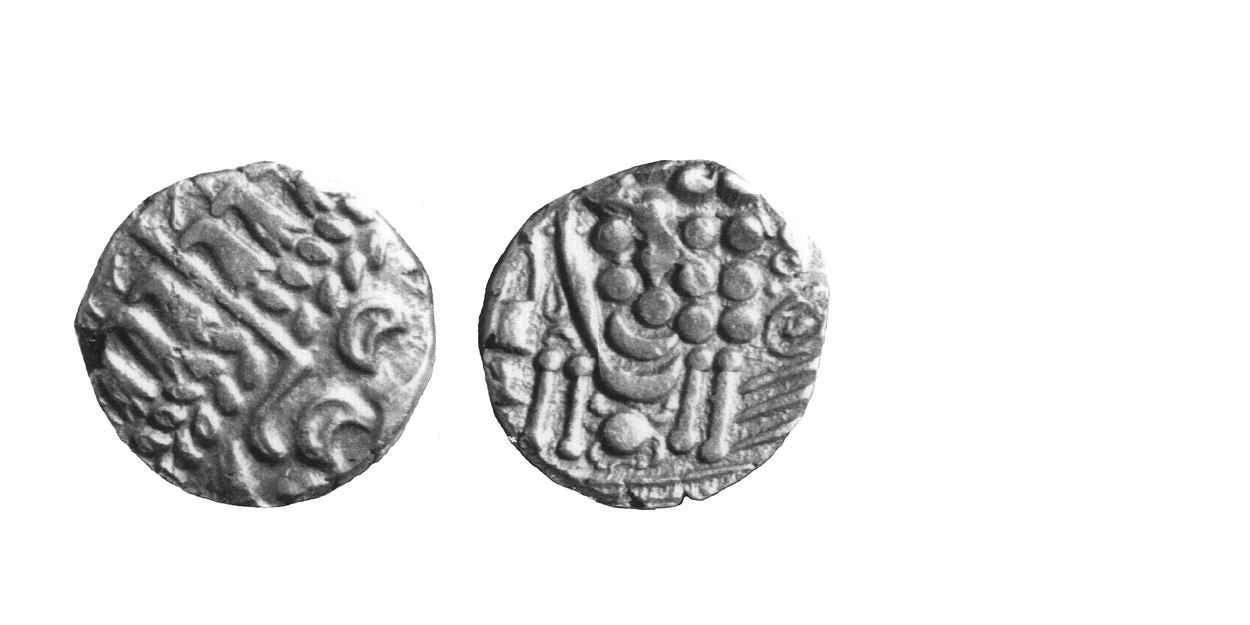
1210 - 01 Chute-Cheriton Transitional Type
ca. 55 B.C. Scarce
Gold Stater ca. 6.2 gms. 18 mm
Earliest Record: Van Arsdell, 1989
OBV: Abstract head of Apollo right
Identifying points:
1) spike with long crescent
2) wreath: leaves upwards
REV: Disjointed horse left
Identifying points:
1) horse has long neck
2) outline teardrop between head and neck
3) 'crab' comprised of pellet with four curved arms below horse
CLASSIFICATION: Durotrigan C
NOTES:
- The weight given is the approximate standard weight, not enough examples exist to determine it accurately
- Celtic Coin Index now indicates commoner than previously thought
- This type contains less gold and more copper than the Chute Type stater
- The change in the laurel leaves' direction probably signals the reduction in intrinsic value
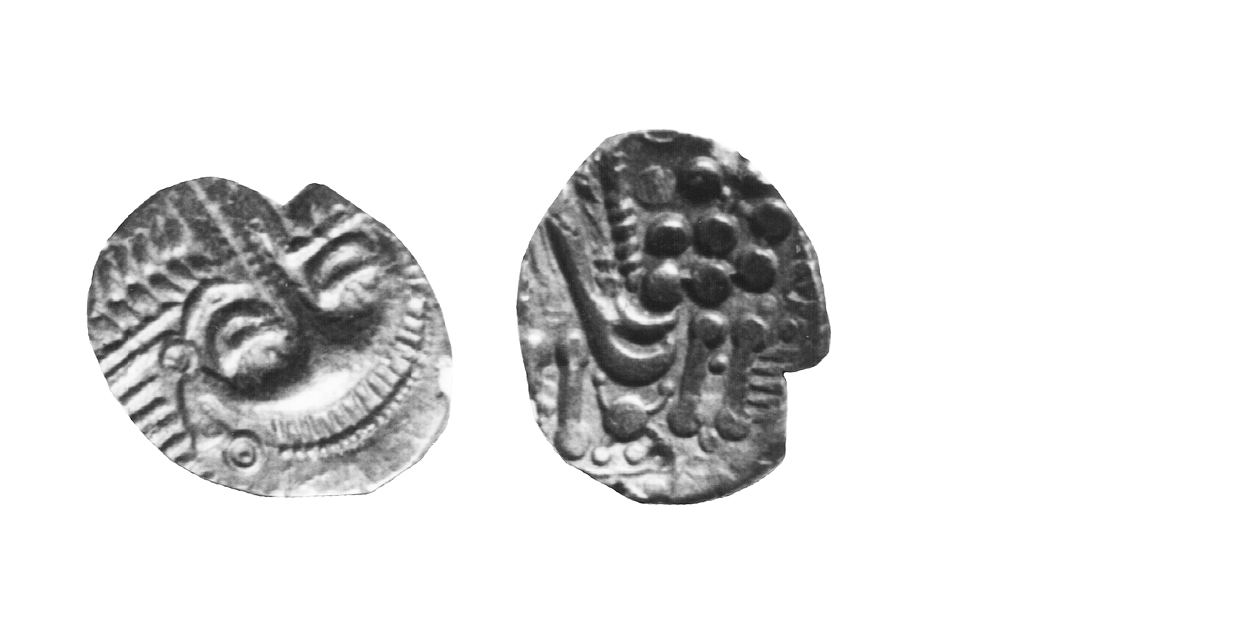
1215 - 01 Cheriton Type
ca. 55 B.C. Common
Gold Stater ca. 5.1 gms. 18 mm
Earliest Record: Evans, 1890
OBV: Abstract head of Apollo right
Identifying points:
1) double spike
2) uppermost spike has large solid crescent terminal from which small lines emanate downwards
3) 'snaffle-bit' to left of crescent
4) wreath: leaves outwards
REV: Disjointed horse left
Identifying points:
1) neck and body form continuous line
2) corded mane
3) 'crab' with four curved arms below horse
4) multiple tails, four or possibly more
CLASSIFICATION: Durotrigan D
NOTES:
- Most are in museums
- Celtic Coin Index now indicates commoner than previously thought
- Very base metal and light weight
- Date may continue to 50 B.C. High tin percentage suggests melted-down cast bronzes were added to debase the alloy
- The number of pellets between the horse's rear legs varies from one to three—possibly indicating a change in metal-content
- Modern forgery known (see 1215 - 01F)
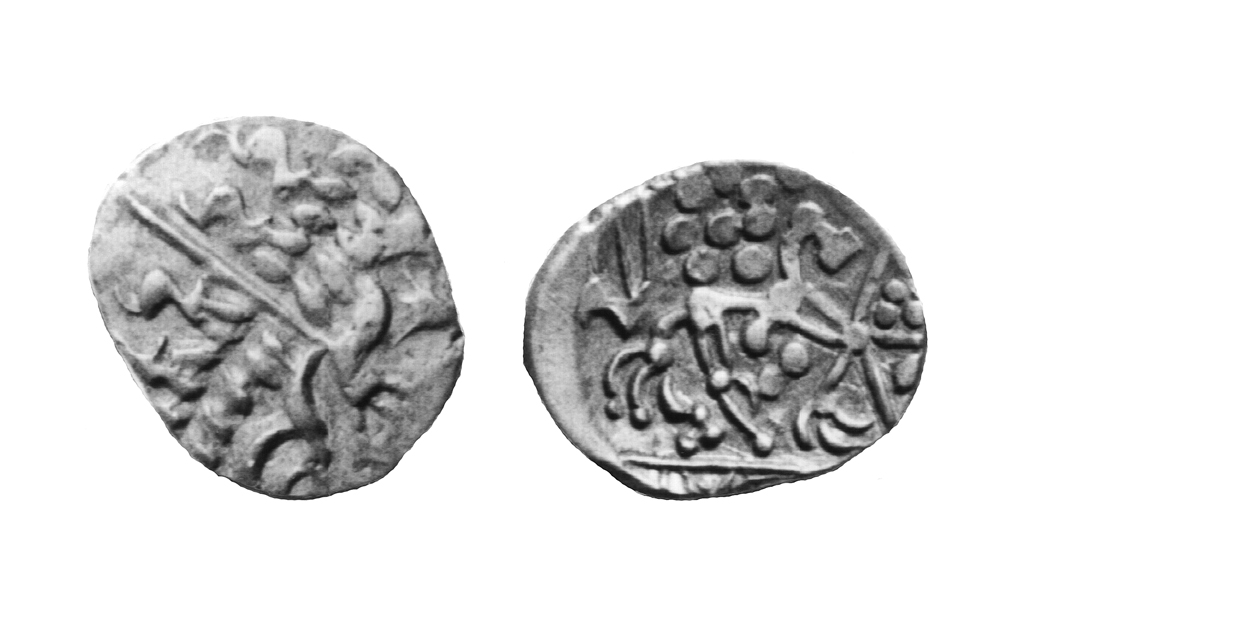
1220 - 01 Yarmouth Type
65-55 B.C. Extremely Rare
Gold Staters 6.1-6.3 gms. 20 mm
Earliest Record: Evans, 1890
OBV: Celticized head of Apollo right
Identifying points:
1) wreath: leaves upwards
2) hook of spike ends in tripod
REV: Disjointed horse right
Identifying points:
1) front leg of horse ends in large wind flower
CLASSIFICATION: Durotrigan B
NOTES:
- Typical weight given
- It is uncertain whether this is a Durotrigan or Atrebatic/Regnan/Belgic coin, it most likely is Durotrigan
- The suggestion that it is a struck by a previously unidentified tribe, the "Vectuarii", is a bizarre speculation
- Most are in museums
- Possibly dates to the middle of the Gallic War
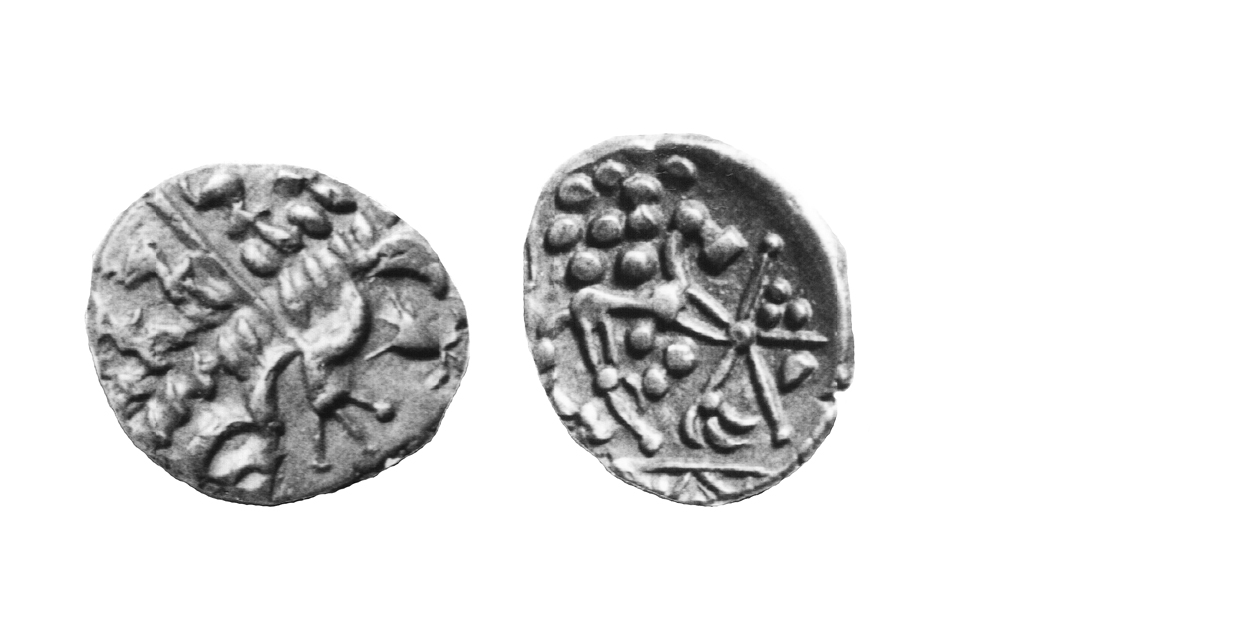
1220 - 01 Yarmouth Type
65-55 B.C. Extremely Rare
Gold Staters 6.1-6.3 gms. 20 mm
Earliest Record: Evans, 1890
OBV: Celticized head of Apollo right
Identifying points:
1) wreath: leaves upwards
2) hook of spike ends in tripod
REV: Disjointed horse right
Identifying points:
1) front leg of horse ends in large wind flower
CLASSIFICATION: Durotrigan B
NOTES:
- Typical weight given
- It is uncertain whether this is a Durotrigan or Atrebatic/Regnan/Belgic coin, it most likely is Durotrigan
- The suggestion that it is a struck by a previously unidentified tribe, the "Vectuarii", is a bizarre speculation
- Most are in museums
- Possibly dates to the middle of the Gallic War
The Coinage of the Durotriges
The Durotriges occupied all of Dorset, parts of Somerset, Wiltshire and Hampshire. They had extensive trading contacts with the Armorican peninsula and consequently their coinage was unlike that of the other British tribes. Armorican coins were primarily silver and billon, and the bulk of the Durotrigan coinage was made of these metals instead of gold.
After their first issues, the Durotriges ignored the mainstream of British coinage, suggesting they were economically isolated. Moreover, their coins circulated less and less beyond the tribal boundaries as time went on, and as the tribe's isolation increased.
Initially however, the Durotrigan coinage was an integral part of the economy of southern Britain. Their first coins were inspired by those of the Atrebates/Regni and these did circulate beyond the tribal borders. The CHUTE TYPE, a gold stater first struck about 65 B.C., was adapted from the Southern Westerham Type of the Atrebates/Regni/Belgae. The Durotrigan moneyers evidently struck the staters using the correct alloy and standard weight at the outset. The Atrebatic/Regnan/Belgic influence was short lived, however, for the tribe had converted to an Armorican-style silver coinage by the middle of the Gallic War.
At the beginning of the Gallic War, the Durotriges did two divergent things to their gold coinage. First, they struck a series of gold staters of increasingly lighter weight and lower gold content. The Chute Type was replaced by the CHUTE-CHERITON TRANSITIONAL TYPE and finally the CHERITON TYPE.
One Cheriton Type Stater has been analyzed metallurgically, and has been found to have a high tin content. This suggests the Durotriges were debasing their gold staters with addition of bronze to the alloy. The Cheriton staters perhaps represented an emergency attempt to maintain a gold coinage for trade with the other British tribes. If this was the case, the attempt failed because production soon stopped.
The second change to the coinage was the introduction of a Southern Westerham Type copy in white gold, which rapidly became debased to silver, billon and ultimately bronze. These coins, although occasionally found outside the tribe's territory, were primarily used in the Durotrigan economy since no other tribe used such coins. The series was long-lived, with many types issued in succession. The silver stater and its billon descendants are accompanied by fractional denominations.
Whether the Durotriges went to a silver standard because of the preferences of their Armorican partners, or because they simply ran out of gold bullion, is uncertain. Their trading contacts used mostly silver coins, and by the time of the Gallic War were using them exclusively. After the defeat of the Venetic Fleet and conquest of Armorica by the Romans, the Durotriges ran out of bullion of all types, because their trade with the continent was cut off. They had already been excluded from the British trading networks by strong competition from the Atrebates/Regni/Belgae and Trinovantes/Catuvellauni. Durotrigan silver coins ceased about 30 B.C., and were replaced by struck bronze staters of increasingly crude style. The silver fractional denominations disappeared entirely.
A series of cast bronzes follows, starting probably in the first century A.D., and known mostly from two large hoards. A small number of extremely rare silver coins carrying the inscription CRAB are found in Durotrigan territory. Although these pieces appear Atrebatic/Regnan/Belgic in style, they have been attributed traditionally to the Durotriges because of the findspots.
The Durotrigan coinage would have come to an end in the mid-forties A.D. as Vespasian's legions overran the tribal territory. The tribe offered difficult resistance to the Roman invasion and their coinage would have been ruthlessly suppressed. Durotrigan coins are sometimes found in surprisingly late hoards of Roman pieces, but probably these represented curiosities at the time of deposit.
The site of the Durotrigan mint has never been located with certainty, and several mints may have been in operation. One likely place was the trading port at Hengistbury. Some of the rare varieties of billon staters may have been irregular issues, struck by local authorities.
The moneyers produced flans by the 'Flat Rock' method, pouring molten metal directly on a smooth surface. Some of the coins display splash appendages produced during the flan pouring operation. The Durotriges learned the technique from Armorican moneyers, whose coins also show the appendages. The early gold and silver coins were well-struck, but the later billon ones were hastily produced in enormous numbers and were consequently less well made. The manufacturing methods for the cast coins have never been studied, and represent an opportunity for original research.
A number of plated forgeries of silver staters are known and sometimes it is difficult to distinguish between plated cores and struck bronzes. Conceivably, all struck bronzes may originally have been silver coated.
